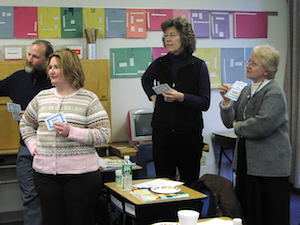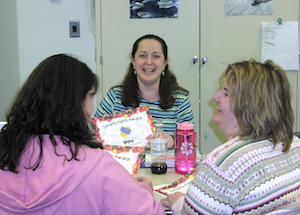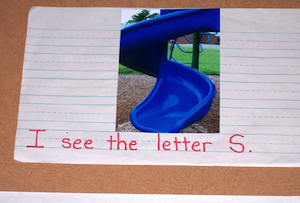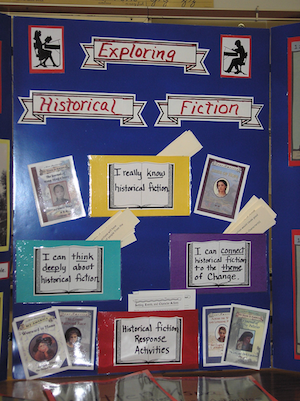Listed below are Patti’s workshop titles. Click on the workshop title to go directly to the workshop description.
Differentiation Titles

- Differentiation: Organize your Differentiation Efforts with a Framework and Structures
- Differentiation: Meeting the Needs of Six Types of Learners
- Differentiation: Tier instruction Using the Drapeau Formulas
- Instructional Tools and Strategies for the Differentiated Classroom
- Graphic Organizers as Tools to Foster Student’s Critical and Creative Thinking in the Differentiated Classroom
- Managing the Learning Environment in the Differentiated Classroom
- RTI Tier 1 Differentiation
- Differentiation for School Leaders
Critical Thinking, Creativity, and Rigor Titles
- How to Teach Creatively Whether you are Creative or Not
- A Critical Approach to Creativity and the Standards
- Designing Creative Tasks that Interest, Engage, and Motivate Students
- Creativity and Imagination: Unlocking the Power of Imagination
- Rigor: Making Deep Learning Accessible to All
- Higher Order Thinking and Assessment: Realizing what Counts
Gifted and Talented Titles
- Teaching Gifted and High Ability Students in the Regular Classroom
- Establishing, Refining, and Evaluating a Gifted and Talented Program
- Programs for the Gifted in Tough Economic Times
- Straight Talk to Parents of Gifted and Talented Children
Online Opportunity: Announcing a New Differentiated Three-Tiered System of Professional Development for Educators
Listed below are detailed descriptions of Patti’s workshops.
Differentiation
1. Differentiation: Organize your Differentiation Efforts with a Framework and Structures

In this session, a variety of structures and a framework provide teachers with a systematic approach to differentiation. A self -assessment helps teachers to reflect upon what they already know about differentiation. A differentiation continuum guides teachers to understand what they should focus on next. The differentiation planner provides a framework for teachers to use when planning their differentiation unit. The differentiation log helps teachers to document their differentiation efforts. Topics include how to use: the framework, the continuum, a planner, a log, a variety of instructional strategies and assessment tools.
2. Differentiation: Meeting the Needs of Six Types of Learners
Participants will use the presenter’s survey to identify the potentialities of the following six types of learners: academic, perfectionist, creative, invisible, struggling and high- energy learners. In this session we will look at ways to use the survey in order to determine appropriate interventions specific to the different types of learners. Topics include: identifying six types of learners; addressing the strengths/weaknesses of each type of learner; grouping each type of learner effectively; and utilizing instructional strategies specific to each learner.
3. Differentiation: Tier Instruction using the Drapeau Formulas
The presenter introduces teachers to a system of creating tiered questions whereby teachers can change the content, thinking process, and/or product of a question based on one of the five Drapeau formulas. Using this system, teachers can easily modify part or all of a question in order to meet the different ability levels in the classroom. This is an efficient and effective system that provides teachers with a way to structure their tiered questions without having to come up with new ideas from scratch. We discuss why to tier questions, how to tier questions, when to tier questions and how to manage them in the classroom.
4. Instructional Tools and Strategies for the Differentiated Classroom
Active learning is engaging and motivating for students of all ages. Teaching tools and strategies can be used to differentiate the content, process, and or product. This workshop is full of activities such as cubing, spinners, card selection, vocabulary trees, two and three dimensional graphic organizers, tic tack toe boards and gaming. Patti shares student responses using these types of tools and evidence that differentiation can be engaging, fun, and make a difference in student engagement and achievement.
5. Graphic Organizers as Tools to Foster Student’s Critical and Creative Thinking in the Differentiated Classroom
Based on Patti’s book by this title, the focus of this session is to encourage teachers to foster critical and creative thinking and depth of reasoning through the use of cognitive graphic organizers in the differentiated classroom. Teachers will learn six different ways to differentiate using graphic organizers. Rating scales and rubrics are provided for each graphic organizer. These assessment tools can be used as a guide to give student feedback, to assess student responses or, to provide students with a self -assessment tool. Topics include: a list of ten principles of differentiated instruction paired with ways to use graphic organizers; six specific ways to differentiate using graphic organizers; integration of critical and creative thinking graphic organizers with content; the use of shared procedural language and; critical and/or creative thinking rating scales or rubrics.
6. Managing the Learning Environment in the Differentiated Classroom
In this session, we address teachers’ questions and concerns about how to manage differentiation in the classroom. What does differentiation look like if it is done well? How can teachers group students in order to make group work effective? How do teachers create an optimal learning environment? What types of contracts or systems should be in place to help students be in control of their learning? This session provides the nuts and bolts of differentiation.
7. RTI Tier 1 Differentiated Instruction
In this session we address issues surrounding disengaged learners and appropriate interventions at the tier 1 level. Students who have executive function problems may demonstrate lack motivation and exhibit disruptive behaviors. Educators will explore reasons for disengagement and determine specific tier 1 strategies that are effective.
8. Differentiation for School Leaders
This session provides an overview of the theory, rationale, misconceptions, and challenges of differentiation in practice. An emphasis is placed on what administrators and school leaders can do to help their teachers improve their differentiation practices. Administrators will receive an observation rubric that will help them focus their classroom observations and provide them with language to use with teachers in order to communicate differentiation growth targets.
Critical Thinking, Creativity, and Rigor
1. How to Teach Creatively Whether you are Creative or Not

How can we target creativity as an instructional approach in a standardized based climate? In this session we look for answers in the definitions of creativity and in the research on alternative ways to make meaning. Teachers are encouraged to promote intellectual interest sparked by creativity, innovation and problem solving. This session is bursting with activities that promote creative thinking and are anchored in content standards. The activities focus on fluent, flexible, original, and elaborative thinking while fostering academic rigor. Student responses in a variety of content areas demonstrate how teachers have used techniques such as sound, color, and imagery effectively in their classrooms. As a result of this session, teachers will learn about the characteristics of creative students, what motivates them, and tools to promote creativity with all students. Topics include: creativity definitions, research on student creativity, creative processes, creative strategies and techniques, creative products, and assessing creativity.
2. A Critical Approach to Creativity and the Standards
Would you like to utilize creativity strategies in your standards based lessons? Do you believe creativity can help students know and understand content so that they can achieve the standards? Creative instruction should be designed to promote deep learning with all students. In this session, the presenter shares creativity tips and compares typical lessons with creative ones. The presenter takes one lesson based on a standard and changes it many different ways to demonstrate how one lesson can be tweaked to foster creative thinking.
3. Designing Creative Tasks that Interest, Engage, and Motivate Students
Highly effective teachers encourage and engage their students. It is not enough to be able to plan and design lessons. Teachers must get their students’ attention and facilitate an atmosphere that welcomes participation. When your lesson falls flat or you have dull lessons in your unit, what do you do to shake things up? How can you turn basic skill lessons into lessons that are inspirational and motivate students? In this session, the presenter will share tools to promote student engagement related to attention, memory, persistence, and self-regulation. Strategies using imagination, creativity and innovation do play a key role in engaging students in the learning process. The presenter will see share examples of student responses using specific techniques.
4. Creativity and Imagination: Unlocking the Power of Imagination
Bring the WOW into teaching and learning by activating dendrites through imaginative thinking. Imagination sparks possibility thinking, enables us to envision potential and allows us to deepen our understanding of complex concepts and problems. In this workshop, educators will explore ways to target imagination in schools, create lessons that utilize imaginative thinking linked to one of four creative thinking skills and experience a variety of strategies to promote imaginative thinking. Join the discussion to help make creativity and imagination a national imperative in schools.
5. Rigor: Making Deep Learning Accessible to All
Transformative learning is defined as learning that takes place when the learner uses a right or wrong answer to move beyond what the question asks. In order to explore a deeper level of knowing, the information in this session emphasizes the four basic building blocks of curriculum. These building blocks include the following four elements: rigor, relevance, recursion, richness, and reflection. By demanding intellectual challenge from all students, teachers take on an “Oh yes they can” attitude. Educators can move even academically struggling students through levels of content complexity and depth of reasoning by providing students with structures and strategies that make deep learning accessible to all.
6. Higher Order Thinking and Assessment: Realizing what Counts

Teachers are encouraged to treat students as thinkers. In order to help students know and understand how to get better at their thinking, teachers use an assessment and feedback system that is timely and specific. Assessment tools such as rubrics and tests often assess only content and/or products. In this session, the presenter demonstrates how to assess critical and creative thinking by showing examples that involve criteria that is quantitatively and qualitatively specific, measureable and observable. The presenter addresses how to assess higher order thinking in a single event assessment (formative or summative assessment) as well as how to show growth over time.
Gifted and Talented
1. Teaching Gifted Students in the Regular Classroom
In this session, we talk about the characteristics of gifted and talented students and how the characteristics determine the students’ needs from which we determine appropriate curriculum responses. We talk about curriculum options such as: differentiating the content, process, and product; utilizing instructional strategies; developing a curriculum compactor; designing challenging independent study and developing mentoring programs. Learn how important it is to differentiate “enough” by extending and/or enriching curriculum in order to promote increased levels of challenge for high ability students. The session concludes with a brief discussion of management, scheduling, grouping, and assessment issues.
2. Establishing, Refining, and Evaluating a Gifted and Talented Program
This workshop is for administrators, team leaders, and teacher/coordinators of the gifted and talented who are responsible for providing programming for gifted and talented students. Whether starting a program from scratch, building a program, or auditing an existing gifted and talented program, this workshop addresses the key components of programming. The topics include: definitions, philosophy, identification, curriculum and instruction, program prototype, professional development and, evaluation.
3. Programs for the Gifted in Tough Economic Times
This is a nuts and bolts presentation about how gifted programs not just survive in tough economic times but thrive. This session focuses on alignment between identification, program provisions, and program evaluation. What does the research say about great practices in programming for the gifted and, how do we use this information to move forward in our vision of quality programs a tough economic climate? Does this information drive us to consider new directions in gifted education? Sound decision-making should determine the program design for gifted students. We must be able to explain what it is we are doing and why we are doing it and how well it is working to justify our programs to others. Key topics in this session include: a comparison between what research says about best practices in regular and gifted education; why program evaluation components must begin when the program starts; why the relationship between the program design and district policy is so critical; and how the budget can support identified students effectively, efficiently, and economically.
4. Straight Talk to Parents of Gifted and Talented Children
This session is a parent’s guide to gifted and talented children in school. We begin by looking at the social emotional needs of gifted and talented children and their general characteristics. We discuss their strengths and their needs and how these may play out at home and at school. In this session, the topics include: what do we mean by gifted, how does the school provide for gifted students, how can parents support the school and, what might parents do at home to promote their child’s abilities.
Online Opportunity: Announcing a new Differentiated Three-Tiered System of Professional Development for Educators
1. Unlocking the Power of Creativity
A new differentiated professional development opportunity on creativity is in development. The online professional development module launch date is summer of 2016. This e-module style of professional development will be conducted electronically for school district teams, professional learning communities and/or individual educators who are interested in learning more about creativity and integrating creativity into their lessons. The e-module is designed to be a flexible three-tiered system where educators can choose to participate in a level designed to meet their individual or group needs.